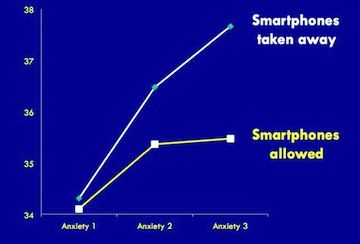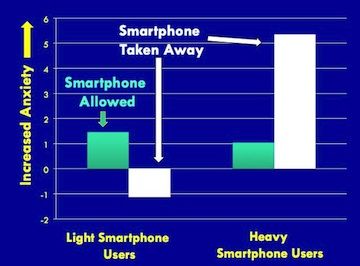Anxiety
Phantom Pocket Vibration Syndrome
What does it tell us about our obsession with technology?
Posted May 7, 2013 Reviewed by Davia Sills
Have you had this experience? If you keep your phone in your pocket, you sometimes (maybe even often) feel a vibration in the skin adjacent to your pocket and pull out your mobile phone, assuming it is a text or some sort of notification, only to discover that it was a phantom vibration. Or, if you keep your phone in a purse or satchel, you imagine that you heard it vibrating, or even ringing, only to discover that it was a false alarm.
According to Dr. Michelle Drouin, a professor at Indiana University-Purdue University in Fort Wayne, Indiana, 89 percent of the undergraduates in her study had experienced these phantom vibrations about every two weeks on average, although only one in 11 classified them as “bothersome.” Those who reacted more emotionally to text messages and were more dependent on text messaging were more bothered by them.
If they were not bothersome, then why would anyone worry about them?
The issue is not whether we are consciously bothered by a phantom vibration, but rather, I believe, if our brains are unconsciously bothered. I am not a neuroscientist (although I am embarking on research paradigm that assesses prefrontal cortex activity, so perhaps in the future I may classify myself as a “pseudo” neuroscientist), but I do read a lot of neuroscience research, and what strikes me is that much of what appears to be happening in our outward behavior can be traced to neurotransmitters in our brain.
For example, for decades now psychiatrists have been prescribing a class of psychotropic medications called SSRIs, or selective serotonin reuptake inhibitors, whose sole purpose is to maintain a high level of a neurotransmitter called serotonin in the brain with the result (hopefully) being increased positive affect or, perhaps, reduced feelings of depression. Whether you agree with the actual impact of SSRIs is irrelevant. Just the fact that psychiatrists prescribe them to manipulate the amount of a neurotransmitter means that they are part of a paradigm that deals with brain chemistry.
I talked about phantom vibrations in my book, iDisorder, and in our research, we now always ask our participants about how often they check in with their devices or websites and their perceived anxiety about not being able to check-in as often as they would like. The table and figure below, taken from a recent article entitled, “Is Facebook Creating ‘iDisorders’? The Link Between Clinical Symptoms of Psychiatric Disorders and Technology Use, Attitudes, and Anxiety,” published in Computers in Human Behavior by my colleagues and I, plus data from some yet-unpublished additional research, provides a glimpse into why so many younger people—and some older people, too—are feeling these phantom vibrations.
The table below shows how often members of four generations of Americans—the iGeneration (born in the 1990s), Net Generation (born in the 1980s), Generation X (born between 1965 and 1979), and Baby Boomers (born between 1946 and 1964)—check-in with various technologies every 15 minutes or less. As you can see, two out of three members of the two youngest generations are constantly checking in with their text messages (and thus, their smartphones), and one in three are checking their cell phone calls and social media equally often. These estimates may even be a bit low, according to a recent Nokia study, which found that the average mobile phone user checks their phone every 6.5 minutes during the day or 150 times during their waking hours.

The figure below shows the percentages of each generation who get moderately-to-highly anxious if they can’t check in as often as they would like. It is clear that half of the two younger generations are anxious if they can’t check those vibrating text messages, and many even get anxious if they can’t check in with their phone calls or social media. It appears, from the tall yellow bar at the far right, that Baby Boomers like myself only get anxious if we can’t check in with our voicemail. In addition, that same study found that those who were more anxious about not being able to check in with Facebook and/or text messages showed more symptoms of major depression, dysthymia, mania, antisocial personality disorder, narcissism, compulsive personality disorder, and paranoid personality disorder.

So, it is clear to me that while phantom vibrations may not be overtly bothersome—after all, how long does it take to check your phone?—they are potentially increasing the flow of neurotransmitters, such as norepinephrine, dopamine, epinephrine, and corticotropin-releasing hormones, and decreasing the flow of serotonin and gamma-aminobutyric acid.
Although our lab does not have the ability to measure the release or suppression of neurotransmitters, my colleague, Dr. Nancy Cheever, recently completed a study that sheds some light on what may be going on. Dr. Cheever recruited 163 college students who were told to report to a large room. Half were directed randomly through one door and told to put their books, phones, and anything else they had with them away under the desks and tables, while the other half were told to relinquish their phones and stow their books and other materials. All students were then told they were to do nothing but wait for further instructions.
Every 20 minutes, for an hour, each participant completed the state portion of the State-Trait Anxiety Scale. As you can see from the figure below, the control group, the ones who were allowed to keep but not use their phones, did show a slight increase in anxiety from the first testing (20 minutes into the session), but their anxiety appeared to level off and not increase between the second and third measurement points. The group that had their smartphones taken away showed a more drastic increase both between the first two measurements and the second and third measurements.

An even more interesting result was discovered when the participants were separated, based on their self-reported use, into heavy and light smartphone users. The next graph shows the increase in anxiety for these two groups separated by those who had their phones taken away (white bars) and those who were allowed to keep but not look at their phones (green bars). As you can see, it is those heavy smartphone users who showed the greatest increase in anxiety across the 60 minutes.

Recently I wrote a blog post on a phenomenon called FOMO or Fear of Missing Out. I think that these two phenomena, FOMO and phantom vibration syndrome, both capture the same prevailing issue. We are now so primed with anxiety about our electronic world (and particularly that which involves communicating, such as text messages and social media) that we misinterpret a simple signal from our neurons located below our pocket as an incoming message, rather than an itch that needs to be scratched. As we are finding out, it really seems to be all about the anxiety that builds up when we are not allowed to check in with our social media, which young people appear to check extremely often.
In a recent interview for Computerworld, I was asked, “Talk about the phantom vibration syndrome, where it feels as if the cell phone is vibrating, but it isn’t. Why does this happen?”
My response sums up what I think is happening to young people and really to anyone who is constantly checking in with their technologies all day long:
Our body is always in waiting to anticipate any kind of technological interaction, which usually comes from a smartphone. With that anticipatory anxiety, if we get any neurological stimulation, our pants rubbing against our leg, for example, you might interpret that through the veil of anxiety, as, 'Oh, my phone is vibrating.'”
If you believe, as I believe, that anxiety-related neurotransmitters are making us interpret random neurological signals as potential cell phone transmissions, then we must start taking steps to retrain ourselves and reduce these anxiety reactions. They are not good for us and will end up potentially keeping us so keyed up that we will not be able to focus or even rest.
The last chapter of my iDisorder book takes the approach that we must learn from neuroscience research what calms our brains. Some of the suggestions include the following, which each need to be done for 10 minutes every couple of hours:
- Take a short walk in nature or just go outside.
- Do a short mindful meditation session.
- Exercise.
- Listen to music.
- Sing.
- Practice a foreign language.
- Read a joke book.
- Talk to someone in person or on the phone.
Actually, you probably already know what it takes to calm your brain. About every 90 minutes to two hours, do something for 10 minutes away from technology, and your anxiety levels should decrease. Another hint is to only access your electronic communications websites (e-mail, texts, social media) on a schedule, say every 15 minutes, and then turn them off during the downtimes.
Unless it’s an emergency, nobody will freak out if you don't get back to him or her within 15 minutes. If you are concerned about missing a “real” emergency from someone, arrange a special communication channel for that person and leave that one active while silencing all the others.




